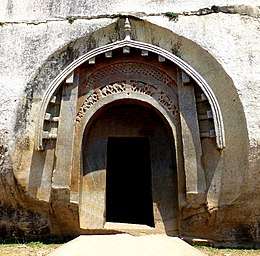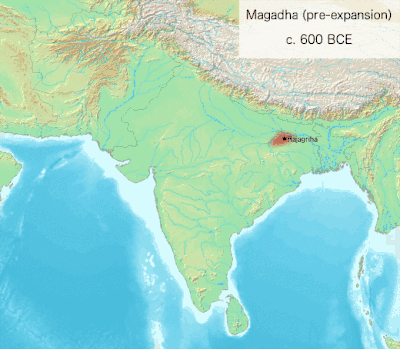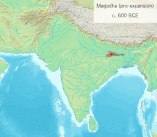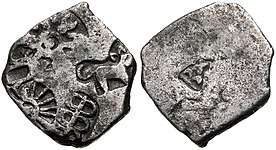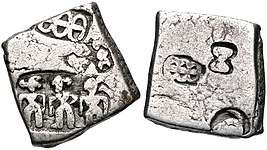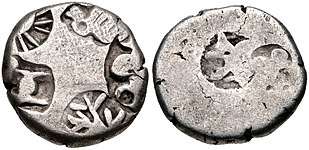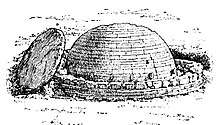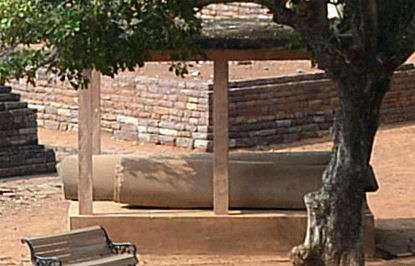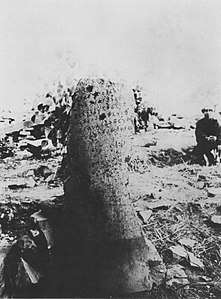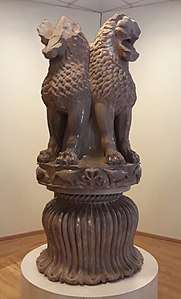Maurya Empire
The Maurya Empire was a geographically extensive Iron Age historical power based in Magadha and founded by Chandragupta Maurya which dominated the Indian subcontinent between 322 and 185 BCE. Comprising the majority of South Asia, the Maurya Empire was centralized by the conquest of the Indo-Gangetic Plain, and its capital city was located at Pataliputra (modern Patna).[14][15] The empire was the largest political entity that has existed in the Indian subcontinent, extending over 5 million square kilometres (1.9 million square miles) at its zenith under Ashoka.[16]
Maurya Empire | |||||||||||||||||||||||
|---|---|---|---|---|---|---|---|---|---|---|---|---|---|---|---|---|---|---|---|---|---|---|---|
| 323 BCE – 184 BCE | |||||||||||||||||||||||
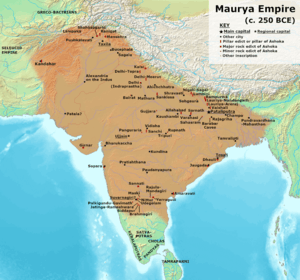 Maximum extent of the Maurya Empire, as shown by the location of Ashoka's inscriptions, and visualized by historians: Vincent Arthur Smith;[1] R. C. Majumdar;[2] and historical geographer Joseph E. Schwartzbert.[3] | |||||||||||||||||||||||
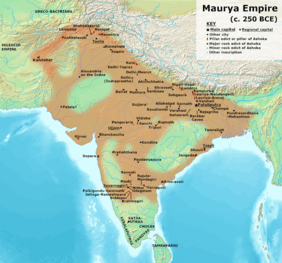 Territories of the Maurya Empire conceptualized as core areas or linear networks separated by large autonomous regions in the works of scholars such as: historians Hermann Kulke and Dietmar Rothermund;[4] Burton Stein;[5] David Ludden;[6] and Romila Thapar;[7] anthropologists Monica L. Smith[8] and Stanley Tambiah;[7] archaeologist Robin Coningham;[7] and historical demographer Tim Dyson.[9] | |||||||||||||||||||||||
| Capital | Pataliputra (Present-day Patna, Bihar) | ||||||||||||||||||||||
| Common languages | Magadhi Prakrit | ||||||||||||||||||||||
| Religion | |||||||||||||||||||||||
| Government | Absolute monarchy, as described in Chanakya's Arthashastra and Rajamandala[10] | ||||||||||||||||||||||
| Emperor | |||||||||||||||||||||||
• 322–298 BCE | Chandragupta | ||||||||||||||||||||||
• 298–272 BCE | Bindusara | ||||||||||||||||||||||
• 268–232 BCE | Ashoka | ||||||||||||||||||||||
• 232–224 BCE | Dasharatha | ||||||||||||||||||||||
• 224–215 BCE | Samprati | ||||||||||||||||||||||
• 215–202 BCE | Shalishuka | ||||||||||||||||||||||
• 202–195 BCE | Devavarman | ||||||||||||||||||||||
• 195–187 BCE | Shatadhanvan | ||||||||||||||||||||||
• 187–180 BCE | Brihadratha | ||||||||||||||||||||||
| Historical era | Iron Age | ||||||||||||||||||||||
| 323 BCE | |||||||||||||||||||||||
• Assassination of Brihadratha by Pushyamitra Shunga | 184 BCE | ||||||||||||||||||||||
| Area | |||||||||||||||||||||||
• Total | 5,000,000 km2 (1,900,000 sq mi) (1st In India) | ||||||||||||||||||||||
| 261 BCE[11] | 3,400,000 km2 (1,300,000 sq mi) | ||||||||||||||||||||||
| 250 BCE[12] | 5,000,000 km2 (1,900,000 sq mi) | ||||||||||||||||||||||
| Population | |||||||||||||||||||||||
• 261 BCE[13] | 50 million | ||||||||||||||||||||||
| Currency | Panas | ||||||||||||||||||||||
| |||||||||||||||||||||||
| Today part of | India Bangladesh Pakistan Nepal Afghanistan | ||||||||||||||||||||||
| Maurya Empire (322–180 BCE) | ||||||||||||||||||||
|---|---|---|---|---|---|---|---|---|---|---|---|---|---|---|---|---|---|---|---|---|
|
||||||||||||||||||||
Chandragupta Maurya raised an army, with the assistance of Chanakya, author of Arthasastra,[17] and overthrew the Nanda Empire in c. 322 BCE. Chandragupta rapidly expanded his power westwards across central and western India by conquering the satraps left by Alexander the Great, and by 317 BCE the empire had fully occupied northwestern India.[18] The Mauryan Empire then defeated Seleucus I, a diadochus and founder of the Seleucid Empire, during the Seleucid–Mauryan war, thus acquiring territory west of the Indus River.[19][20]
At its greatest extent, the empire stretched along the natural boundary of the Himalayas, to the east into Bengal, to the west into what is present-day Balochistan, Pakistan and the Hindu Kush mountains of what is now eastern Afghanistan.[21] The dynasty expanded into India's southern regions[22][23] by the reign of the emperor Bindusara, but it excluded Kalinga (modern Odisha), until it was conquered by Ashoka.[24] It declined for about 50 years after Ashoka's rule, and dissolved in 185 BCE with the foundation of the Shunga dynasty in Magadha.
Under Chandragupta Maurya and his successors, internal and external trade, agriculture, and economic activities thrived and expanded across South Asia due to the creation of a single and efficient system of finance, administration, and security. The Maurya dynasty built the Grand Trunk Road, one of Asia's oldest and longest trade networks, connecting the north of the Indian subcontinent from east to west.[25] After the Kalinga War, the Empire experienced nearly half a century of centralized rule under Ashoka. Chandragupta Maurya's embrace of Jainism increased socio-religious reform across South Asia, while Ashoka's embrace of Buddhism and sponsorship of Buddhist missionaries allowed for the expansion of that faith into Sri Lanka, northwest India, Central Asia, Southeast Asia, Egypt, and Hellenistic Europe.[26]
The population of the empire has been estimated to be about 50–60 million, making the Mauryan Empire one of the most populous empires of antiquity.[27][28] Archaeologically, the period of Mauryan rule in South Asia falls into the era of Northern Black Polished Ware (NBPW). The Arthashastra[29] and the Edicts of Ashoka are the primary sources of written records of Mauryan times. The Lion Capital of Ashoka at Sarnath is the national emblem of the modern Republic of India.
Etymology
The name "Maurya" does not occur in Ashoka's inscriptions, or the contemporary Greek accounts such as Megasthenes's Indica, but it is attested by the following sources:[30]
- The Junagadh rock inscription of Rudradaman (c. 150 CE) prefixes "Maurya" to the names Chandragupta and Ashoka.[30]
- The Puranas (c. 4th century CE or earlier) use Maurya as a dynastic appellation.[30]
- The Buddhist texts state that Chandragupta belonged to the "Moriya" clan of the Shakyas, the tribe to which Gautama Buddha belonged.[30]
- The Jain texts state that Chandragupta was the son of a royal superintendent of peacocks (mayura-poshaka).[30]
- Tamil Sangam literature also designate them as 'moriyar' and mention them after the Nandas[31]
- Kuntala inscription (from the town of Bandanikke, North Mysore ) of 12th century AD chronologically mention Mauryya as one of the dynasties which ruled the region.[32]
According to some scholars, Kharavela's Hathigumpha inscription (2nd-1st century BC) mentions era of Maurya Empire as Muriya Kala (Mauryan era),[33] but this reading is disputed: other scholars—such as epigraphist D. C. Sircar—read the phrase as mukhiya-kala ("the principal art").[34]
According to the Buddhist tradition, the ancestors of the Maurya kings had settled in a region where peacocks (mora in Pali) were abundant. Therefore, they came to be known as "Moriyas", literally, "belonging to the place of peacocks". According to another Buddhist account, these ancestors built a city called Moriya-nagara ("Moriya-city"), which was so called, because it was built with the "bricks coloured like peacocks' necks".[35]
The dynasty's connection to the peacocks, as mentioned in the Buddhist and Jain traditions, seems to be corroborated by archaeological evidence. For example, peacock figures are found on the Ashoka pillar at Nandangarh and several sculptures on the Great Stupa of Sanchi. Based on this evidence, modern scholars theorize that the peacock may have been the dynasty's emblem.[36]
Some later authors, such as Dhundiraja (a commentator on the Mudrarakshasa) and an annotator of the Vishnu Purana, state that the word "Maurya" is derived from Mura and the mother of the first Maurya king. However, the Puranas themselves make no mention of Mura and do not talk of any relation between the Nanda and the Maurya dynasties.[37] Dhundiraja's derivation of the word seems to be his own invention: according to the Sanskrit rules, the derivative of the feminine name Mura (IAST: Murā) would be "Maureya"; the term "Maurya" can only be derived from the masculine "Mura".[38]
History
Founding
Mauryas of Pippalivana (which has been identified with Sahankat near Rudrapur) of Kshatriya background were a well known republican tribe mentioned in the Buddhist literature who lived on the Himalayan slopes north of Magadha and Kosala and claimed a share of Buddha relics on his death in 544 BC.[39] The mauryas appear again in connection with the Maurya empire founded by Chandragupta Maurya in 324 BC with help from Chanakya, at Taxila, a noted center of learning. According to several legends, Chanakya travelled to Magadha, a kingdom that was large and militarily powerful and feared by its neighbours, but was insulted by its king Dhana Nanda, of the Nanda dynasty. Chanakya swore revenge and vowed to destroy the Nanda Empire.[40] Meanwhile, the conquering armies of Alexander the Great refused to cross the Beas River and advance further eastward, exhausted by a decade-long campaign and yearning to go home. Alexander returned to Babylon and re-deployed most of his troops west of the Indus River. Soon after Alexander died in Babylon in 323 BCE, his empire fragmented into independent kingdoms led by his generals.[41]
The Greek generals Eudemus and Peithon ruled in the Indus Valley until around 317 BCE, when Chandragupta Maurya (with the help of Chanakya, who was now his advisor) orchestrated a rebellion to drive out the Greek governors, and subsequently brought the Indus Valley under the control of his new seat of power in Magadha.[18]
Chandragupta Maurya's rise to power is shrouded in mystery and controversy. On one hand, a number of ancient Indian accounts, such as the drama Mudrarakshasa (Signet ring of Rakshasa – Rakshasa was the prime minister of Magadha) by Vishakhadatta, describe his royal ancestry and even link him with the Nanda family. A kshatriya clan known as the Mauryas are referred to in the earliest Buddhist texts, Mahaparinibbana Sutta. However, any conclusions are hard to make without further historical evidence. Chandragupta first emerges in Greek accounts as "Sandrokottos". As a young man he is said to have met Alexander.[42] He is also said to have met the Nanda king, angered him, and made a narrow escape.[43] Chanakya's original intentions were to train army under Chandragupta's command.
Conquest of Magadha
Chanakya encouraged Chandragupta Maurya and his army to take over the throne of Magadha. Using his intelligence network, Chandragupta gathered many young men from across Magadha and other provinces, men upset over the corrupt and oppressive rule of king Dhana Nanda, plus the resources necessary for his army to fight a long series of battles. These men included the former general of Taxila, accomplished students of Chanakya, the representative of King Parvataka, his son Malayaketu, and the rulers of small states. The Macedonians (described as Yona or Yavana in Indian sources) may then have participated, together with other groups, in the armed uprising of Chandragupta Maurya against the Nanda dynasty.[45][46] The Mudrarakshasa of Visakhadutta as well as the Jaina work Parisishtaparvan talk of Chandragupta's alliance with the Himalayan king Parvataka, often identified with Porus,[47][48] although this identification is not accepted by all historians.[49] This Himalayan alliance gave Chandragupta a composite and powerful army made up of Yavanas (Greeks), Kambojas, Shakas (Scythians), Kiratas (Himalayans), Parasikas (Persians) and Bahlikas (Bactrians) who took Pataliputra (also called Kusumapura, "The City of Flowers"):[50]
Kusumapura was besieged from every direction by the forces of Parvata and Chandragupta: Shakas, Yavanas, Kiratas, Kambojas, Parasikas, Bahlikas and others, assembled on the advice of Chanakya
Preparing to invade Pataliputra, Maurya came up with a strategy. A battle was announced and the Magadhan army was drawn from the city to a distant battlefield to engage with Maurya's forces. Maurya's general and spies meanwhile bribed the corrupt general of Nanda. He also managed to create an atmosphere of civil war in the kingdom, which culminated in the death of the heir to the throne. Chanakya managed to win over popular sentiment. Ultimately Nanda resigned, handing power to Chandragupta, and went into exile and was never heard of again. Chanakya contacted the prime minister, Rakshasas, and made him understand that his loyalty was to Magadha, not to the Nanda dynasty, insisting that he continue in office. Chanakya also reiterated that choosing to resist would start a war that would severely affect Magadha and destroy the city. Rakshasa accepted Chanakya's reasoning, and Chandragupta Maurya was legitimately installed as the new King of Magadha. Rakshasa became Chandragupta's chief advisor, and Chanakya assumed the position of an elder statesman.
Chandragupta Maurya
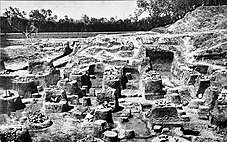
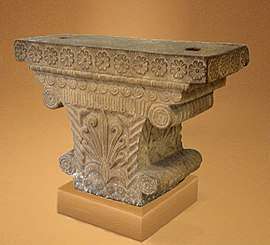
After the death of Alexander the Great in 323 BCE, Chandragupta led a series of campaigns in 305 BCE to retake satrapies in the Indus Valley and northwest India.[52] When Alexander's remaining forces were routed, returning westwards, Seleucus I Nicator fought to defend these territories. Not many details of the campaigns are known from ancient sources. Seleucus was defeated and retreated into the mountainous region of Afghanistan.[53]
The two rulers concluded a peace treaty in 303 BCE, including a marital alliance. Under its terms, Chandragupta received the satrapies of Paropamisadae (Kamboja and Gandhara) and Arachosia (Kandhahar) and Gedrosia (Balochistan). Seleucus I received the 500 war elephants that were to have a decisive role in his victory against western Hellenistic kings at the Battle of Ipsus in 301 BCE. Diplomatic relations were established and several Greeks, such as the historian Megasthenes, Deimakos and Dionysius resided at the Mauryan court.[54]
Megasthenes in particular was a notable Greek ambassador in the court of Chandragupta Maurya.[55] According to Arrian, ambassador Megasthenes (c. 350 – c. 290 BCE) lived in Arachosia and travelled to Pataliputra.[56] Megasthenes' description of Mauryan society as freedom-loving gave Seleucus a means to avoid invasion, however, underlying Seleucus' decision was the improbability of success. In later years, Seleucus' successors maintained diplomatic relations with the Empire based on similar accounts from returning travellers.[52]
Chandragupta established a strong centralised state with an administration at Pataliputra, which, according to Megasthenes, was "surrounded by a wooden wall pierced by 64 gates and 570 towers". Aelian, although not expressly quoting Megasthenes nor mentionning Pataliputra, described Indian palaces as superior in splendor to Persia's Susa or Ectabana.[57] The architecture of the city seems to have had many similarities with Persian cities of the period.[58]
Chandragupta's son Bindusara extended the rule of the Mauryan empire towards southern India. The famous Tamil poet Mamulanar of the Sangam literature described how areas south of the Deccan Plateau which comprised Tamil country was invaded by the Maurya army using troops from Karnataka. Mamulanar states that Vadugar (people who resided in Andhra-Karnataka regions immediately to the north of Tamil Nadu) formed the vanguard of the Mauryan army.[31][59] He also had a Greek ambassador at his court, named Deimachus.[60] According to Plutarch Chandragupta Maurya subdued entire India, Justin also observed that chandragupta maurya was "in possession of India"; this is corroborated by Tamil sangam literature which mentions about Mauryan invasion with their south Indian allies and defeat of their rivals at Podiyil hill in Tirunelveli district in present-day Tamil Nadu.[61][62]
Chandragupta renounced his throne and followed Jain teacher Bhadrabahu.[63][64][65] He is said to have lived as an ascetic at Shravanabelagola for several years before fasting to death, as per the Jain practice of sallekhana.[66]
Bindusara
.jpg)
Bindusara was born to Chandragupta, the founder of the Mauryan Empire. This is attested by several sources, including the various Puranas and the Mahavamsa.[67] He is attested by the Buddhist texts such as Dipavamsa and Mahavamsa ("Bindusaro"); the Jain texts such as Parishishta-Parvan; as well as the Hindu texts such as Vishnu Purana ("Vindusara").[68][69] According to the 12th century Jain writer Hemachandra's Parishishta-Parvan, the name of Bindusara's mother was Durdhara.[70] Some Greek sources also mention him by the name "Amitrochates" or its variations.[71][72]
Historian Upinder Singh estimates that Bindusara ascended the throne around 297 BCE.[59] Bindusara, just 22 years old, inherited a large empire that consisted of what is now, Northern, Central and Eastern parts of India along with parts of Afghanistan and Baluchistan. Bindusara extended this empire to the southern part of India, as far as what is now known as Karnataka. He brought sixteen states under the Mauryan Empire and thus conquered almost all of the Indian peninsula (he is said to have conquered the 'land between the two seas' – the peninsular region between the Bay of Bengal and the Arabian Sea). Bindusara did not conquer the friendly Tamil kingdoms of the Cholas, ruled by King Ilamcetcenni, the Pandyas, and Cheras. Apart from these southern states, Kalinga (modern Odisha) was the only kingdom in India that did not form part of Bindusara's empire.[73] It was later conquered by his son Ashoka, who served as the viceroy of Ujjaini during his father's reign, which highlights the importance of the town.[74][75]
Bindusara's life has not been documented as well as that of his father Chandragupta or of his son Ashoka. Chanakya continued to serve as prime minister during his reign. According to the medieval Tibetan scholar Taranatha who visited India, Chanakya helped Bindusara "to destroy the nobles and kings of the sixteen kingdoms and thus to become absolute master of the territory between the eastern and western oceans".[76] During his rule, the citizens of Taxila revolted twice. The reason for the first revolt was the maladministration of Susima, his eldest son. The reason for the second revolt is unknown, but Bindusara could not suppress it in his lifetime. It was crushed by Ashoka after Bindusara's death.[77]
Bindusara maintained friendly diplomatic relations with the Hellenic world. Deimachus was the ambassador of Seleucid emperor Antiochus I at Bindusara's court.[78] Diodorus states that the king of Palibothra (Pataliputra, the Mauryan capital) welcomed a Greek author, Iambulus. This king is usually identified as Bindusara.[78] Pliny states that the Egyptian king Philadelphus sent an envoy named Dionysius to India.[79][80] According to Sailendra Nath Sen, this appears to have happened during Bindusara's reign.[78]
Unlike his father Chandragupta (who at a later stage converted to Jainism), Bindusara believed in the Ajivika sect. Bindusara's guru Pingalavatsa (Janasana) was a Brahmin[81] of the Ajivika sect. Bindusara's wife, Queen Subhadrangi (Queen Dharma/ Aggamahesi) was a Brahmin[82] also of the Ajivika sect from Champa (present Bhagalpur district). Bindusara is credited with giving several grants to Brahmin monasteries (Brahmana-bhatto).[83]
Historical evidence suggests that Bindusara died in the 270s BCE. According to Upinder Singh, Bindusara died around 273 BCE.[59] Alain Daniélou believes that he died around 274 BCE.[76] Sailendra Nath Sen believes that he died around 273–272 BCE, and that his death was followed by a four-year struggle of succession, after which his son Ashoka became the emperor in 269–268 BCE.[78] According to the Mahavamsa, Bindusara reigned for 28 years.[84] The Vayu Purana, which names Chandragupta's successor as "Bhadrasara", states that he ruled for 25 years.[85]
Ashoka
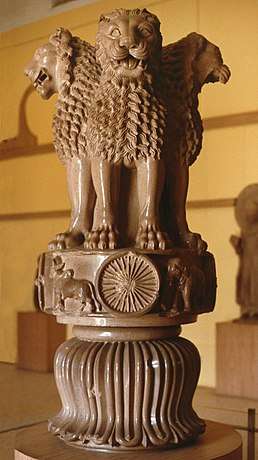
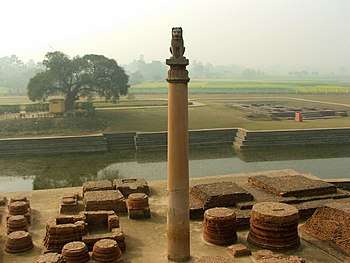
As a young prince, Ashoka (r. 272–232 BCE) was a brilliant commander who crushed revolts in Ujjain and Takshashila. As monarch he was ambitious and aggressive, re-asserting the Empire's superiority in southern and western India. But it was his conquest of Kalinga (262–261 BCE) which proved to be the pivotal event of his life. Ashoka used Kalinga to project power over a large region by building a fortification there and securing it as a possession.[86] Although Ashoka's army succeeded in overwhelming Kalinga forces of royal soldiers and civilian units, an estimated 100,000 soldiers and civilians were killed in the furious warfare, including over 10,000 of Ashoka's own men. Hundreds of thousands of people were adversely affected by the destruction and fallout of war. When he personally witnessed the devastation, Ashoka began feeling remorse. Although the annexation of Kalinga was completed, Ashoka embraced the teachings of Buddhism, and renounced war and violence. He sent out missionaries to travel around Asia and spread Buddhism to other countries.
Ashoka implemented principles of ahimsa by banning hunting and violent sports activity and ending indentured and forced labor (many thousands of people in war-ravaged Kalinga had been forced into hard labour and servitude). While he maintained a large and powerful army, to keep the peace and maintain authority, Ashoka expanded friendly relations with states across Asia and Europe, and he sponsored Buddhist missions. He undertook a massive public works building campaign across the country. Over 40 years of peace, harmony and prosperity made Ashoka one of the most successful and famous monarchs in Indian history. He remains an idealized figure of inspiration in modern India.
The Edicts of Ashoka, set in stone, are found throughout the Subcontinent. Ranging from as far west as Afghanistan and as far south as Andhra (Nellore District), Ashoka's edicts state his policies and accomplishments. Although predominantly written in Prakrit, two of them were written in Greek, and one in both Greek and Aramaic. Ashoka's edicts refer to the Greeks, Kambojas, and Gandharas as peoples forming a frontier region of his empire. They also attest to Ashoka's having sent envoys to the Greek rulers in the West as far as the Mediterranean. The edicts precisely name each of the rulers of the Hellenic world at the time such as Amtiyoko (Antiochus), Tulamaya (Ptolemy), Amtikini (Antigonos), Maka (Magas) and Alikasudaro (Alexander) as recipients of Ashoka's proselytism. The Edicts also accurately locate their territory "600 yojanas away" (a yojanas being about 7 miles), corresponding to the distance between the center of India and Greece (roughly 4,000 miles).[87]
Decline
Ashoka was followed for 50 years by a succession of weaker kings. He was succeeded by Dasharatha Maurya, who was Ashoka's grandson. None of Ashoka's sons could ascend the throne after him. Mahendra, his first born, was on to spread Buddhism in the world. Kunala Maurya was blind hence couldn't ascend the throne and Tivala, son of Kaurwaki, died even earlier than Ashoka. Another son, Jalauka, does not have much story behind him.
The empire lost many territories under Dasharatha, which were later reconquered by Samprati, Kunala's son. Post Samprati, the Mauryas slowly lost many territories. In 180 BCE, Brihadratha Maurya, was killed by his general Pushyamitra Shunga in a military parade without any heir. Hence, the great Maurya empire finally ended, giving rise to the Shunga Empire.
Reasons advanced for the decline include the succession of weak kings after Aśoka Maurya, the partition of the empire into two, the growing independence of some areas within the empire, such as that ruled by Sophagasenus, a top-heavy administration where authority was entirely in the hands of a few persons, an absence of any national consciousness,[88] the pure scale of the empire making it unwieldy, and invasion by the Greco-Bactrian Empire.
Some historians, such as H. C. Raychaudhuri, have argued that Ashoka's pacifism undermined the "military backbone" of the Maurya empire. Others, such as Romila Thapar, have suggested that the extent and impact of his pacifism have been "grossly exaggerated".[89]
Shunga coup (185 BCE)
Buddhist records such as the Ashokavadana write that the assassination of Brihadratha and the rise of the Shunga empire led to a wave of religious persecution for Buddhists,[90] and a resurgence of Hinduism. According to Sir John Marshall,[91] Pushyamitra may have been the main author of the persecutions, although later Shunga kings seem to have been more supportive of Buddhism. Other historians, such as Etienne Lamotte[92] and Romila Thapar,[93] among others, have argued that archaeological evidence in favour of the allegations of persecution of Buddhists are lacking, and that the extent and magnitude of the atrocities have been exaggerated.
Establishment of the Indo-Greek Kingdom (180 BCE)
The fall of the Mauryas left the Khyber Pass unguarded, and a wave of foreign invasion followed. The Greco-Bactrian king, Demetrius, capitalized on the break-up, and he conquered southern Afghanistan and parts of northwestern India around 180 BCE, forming the Indo-Greek Kingdom. The Indo-Greeks would maintain holdings on the trans-Indus region, and make forays into central India, for about a century. Under them, Buddhism flourished, and one of their kings, Menander, became a famous figure of Buddhism; he was to establish a new capital of Sagala, the modern city of Sialkot. However, the extent of their domains and the lengths of their rule are subject to much debate. Numismatic evidence indicates that they retained holdings in the subcontinent right up to the birth of Christ. Although the extent of their successes against indigenous powers such as the Shungas, Satavahanas, and Kalingas are unclear, what is clear is that Scythian tribes, renamed Indo-Scythians, brought about the demise of the Indo-Greeks from around 70 BCE and retained lands in the trans-Indus, the region of Mathura, and Gujarat.
Military
Megasthenes mentions military command consisting of six boards of five members each, (i) Navy (ii) military transport (iii) Infantry (iv) Cavalry (v) Chariot divisions and (vi) Elephants.[94]
Administration

The Empire was divided into four provinces, with the imperial capital at Pataliputra. From Ashokan edicts, the names of the four provincial capitals are Tosali (in the east), Ujjain (in the west), Suvarnagiri (in the south), and Taxila (in the north). The head of the provincial administration was the Kumara (royal prince), who governed the provinces as king's representative. The kumara was assisted by Mahamatyas and council of ministers. This organizational structure was reflected at the imperial level with the Emperor and his Mantriparishad (Council of Ministers).
Historians theorise that the organisation of the Empire was in line with the extensive bureaucracy described by Kautilya in the Arthashastra: a sophisticated civil service governed everything from municipal hygiene to international trade. The expansion and defense of the empire was made possible by what appears to have been one of the largest armies in the world during the Iron Age.[95] According to Megasthenes, the empire wielded a military of 600,000 infantry, 30,000 cavalry, 8,000 chariots and 9,000 war elephants besides followers and attendants.[96] A vast espionage system collected intelligence for both internal and external security purposes. Having renounced offensive warfare and expansionism, Ashoka nevertheless continued to maintain this large army, to protect the Empire and instil stability and peace across West and South Asia..Even though large parts were under the control of Mauryan empire the spread of information and imperial message was limited since many parts were inaccessible and were situated far away from capital of empire.[97]
Local government
Arthashastra and Megasthenes accounts of Pataliputra describe the intricate municipal system formed by Maurya empire to govern its cities. A city counsel made up of thirty commissioners was divided into six committees or boards which governed the city. The first board fixed wages and looked after provided goods, second board made arrangement for foreign dignitaries, tourists and businessmen, third board made records and registrations, fourth looked after manufactured goods and sale of commodities, fifth board regulated trade, issued licenses and checked weights and measurements, sixth board collected sales taxes. Some cities such as Taxila had autonomy to issue their own coins. The city counsel had officers who looked after public welfare such as maintenance of roads, public buildings, markets, hospitals, educational institutions etc.[98] The official head of the village was Gramika (in towns Nagarika).[99] The city counsel also had some magisterial powers.
Economy
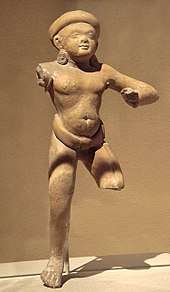
For the first time in South Asia, political unity and military security allowed for a common economic system and enhanced trade and commerce, with increased agricultural productivity. The previous situation involving hundreds of kingdoms, many small armies, powerful regional chieftains, and internecine warfare, gave way to a disciplined central authority. Farmers were freed of tax and crop collection burdens from regional kings, paying instead to a nationally administered and strict-but-fair system of taxation as advised by the principles in the Arthashastra. Chandragupta Maurya established a single currency across India, and a network of regional governors and administrators and a civil service provided justice and security for merchants, farmers and traders. The Mauryan army wiped out many gangs of bandits, regional private armies, and powerful chieftains who sought to impose their own supremacy in small areas. Although regimental in revenue collection, Maurya also sponsored many public works and waterways to enhance productivity, while internal trade in India expanded greatly due to new-found political unity and internal peace.
Under the Indo-Greek friendship treaty, and during Ashoka's reign, an international network of trade expanded. The Khyber Pass, on the modern boundary of Pakistan and Afghanistan, became a strategically important port of trade and intercourse with the outside world. Greek states and Hellenic kingdoms in West Asia became important trade partners of India. Trade also extended through the Malay peninsula into Southeast Asia. India's exports included silk goods and textiles, spices and exotic foods. The external world came across new scientific knowledge and technology with expanding trade with the Mauryan Empire. Ashoka also sponsored the construction of thousands of roads, waterways, canals, hospitals, rest-houses and other public works. The easing of many over-rigorous administrative practices, including those regarding taxation and crop collection, helped increase productivity and economic activity across the Empire.
In many ways, the economic situation in the Mauryan Empire is analogous to the Roman Empire of several centuries later. Both had extensive trade connections and both had organizations similar to corporations. While Rome had organizational entities which were largely used for public state-driven projects, Mauryan India had numerous private commercial entities. These existed purely for private commerce and developed before the Mauryan Empire itself.[100]
| Maurya Empire coinage |
|
Religion
Jainism
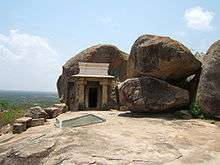
Chandragupta Maurya embraced Jainism after retiring, when he renounced his throne and material possessions to join a wandering group of Jain monks. Chandragupta was a disciple of the Jain monk Acharya Bhadrabahu. It is said that in his last days, he observed the rigorous but self-purifying Jain ritual of santhara (fast unto death), at Shravana Belgola in Karnataka.[102][65][103][64] Samprati, the grandson of Ashoka, also patronized Jainism. Samprati was influenced by the teachings of Jain monks like Suhastin and he is said to have built 125,000 derasars across India.[104] Some of them are still found in the towns of Ahmedabad, Viramgam, Ujjain, and Palitana. It is also said that just like Ashoka, Samprati sent messengers and preachers to Greece, Persia and the Middle East for the spread of Jainism, but, to date, no research has been done in this area.[105][106]
Thus, Jainism became a vital force under the Mauryan Rule. Chandragupta and Samprati are credited for the spread of Jainism in South India. Hundreds of thousands of temples and stupas are said to have been erected during their reigns
Buddhism
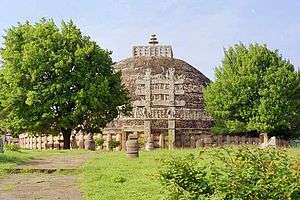
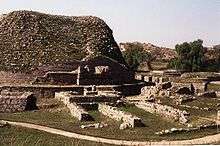
Magadha, the centre of the empire, was also the birthplace of Buddhism. Ashoka initially practised Hinduism but later embraced Buddhism; following the Kalinga War, he renounced expansionism and aggression, and the harsher injunctions of the Arthashastra on the use of force, intensive policing, and ruthless measures for tax collection and against rebels. Ashoka sent a mission led by his son Mahinda and daughter Sanghamitta to Sri Lanka, whose king Tissa was so charmed with Buddhist ideals that he adopted them himself and made Buddhism the state religion. Ashoka sent many Buddhist missions to West Asia, Greece and South East Asia, and commissioned the construction of monasteries and schools, as well as the publication of Buddhist literature across the empire. He is believed to have built as many as 84,000 stupas across India, such as Sanchi and Mahabodhi Temple, and he increased the popularity of Buddhism in Afghanistan, Thailand and North Asia including Siberia. Ashoka helped convene the Third Buddhist Council of India's and South Asia's Buddhist orders near his capital, a council that undertook much work of reform and expansion of the Buddhist religion. Indian merchants embraced Buddhism and played a large role in spreading the religion across the Mauryan Empire.[107]
Architectural remains
The greatest monument of this period, executed in the reign of Chandragupta Maurya, was the old palace at Paliputra, modern Kumhrar in Patna. Excavations have unearthed the remains of the palace, which is thought to have been an group of several buildings, the most important of which was an immense pillared hall supported on a high substratum of timbers. The pillars were set in regular rows, thus dividing the hall into a number of smaller square bays. The number of columns is 80, each about 7 meters high. According to the eyewitness account of Megasthenes, the palace was chiefly constructed of timber, and was considered to exceed in splendour and magnificence the palaces of Susa and Ecbatana, its gilded pillars being adorned with golden vines and silver birds. The buildings stood in an extensive park studded with fish ponds and furnished with a great variety of ornamental trees and shrubs.[108] Kauṭilya's Arthashastra also gives the method of palace construction from this period. Later fragments of stone pillars, including one nearly complete, with their round tapering shafts and smooth polish, indicate that Ashoka was responsible for the construction of the stone columns which replaced the earlier wooden ones.
During the Ashokan period, stonework was of a highly diversified order and comprised lofty free-standing pillars, railings of stupas, lion thrones and other colossal figures. The use of stone had reached such great perfection during this time that even small fragments of stone art were given a high lustrous polish resembling fine enamel. This period marked the beginning of the Buddhist school of architecture. Ashoka was responsible for the construction of several stupas, which were large domes and bearing symbols of Buddha. The most important ones are located at Sanchi, Bharhut, Amaravati, Bodhgaya and Nagarjunakonda. The most widespread examples of Mauryan architecture are the Ashoka pillars and carved edicts of Ashoka, often exquisitely decorated, with more than 40 spread throughout the Indian subcontinent.[109]
The peacock was a dynastic symbol of Mauryans, as depicted by Ashoka's pillars at Nandangarh and Sanchi Stupa.[36]
| Maurya structures and decorations at Sanchi (3rd century BCE) | |
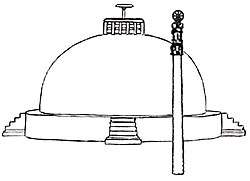 Approximate reconstitution of the Great Stupa at Sanchi under the Mauryas. |
|
Natural history

The protection of animals in India became serious business by the time of the Maurya dynasty; being the first empire to provide a unified political entity in India, the attitude of the Mauryas towards forests, their denizens, and fauna in general is of interest.[112]
The Mauryas firstly looked at forests as resources. For them, the most important forest product was the elephant. Military might in those times depended not only upon horses and men but also battle-elephants; these played a role in the defeat of Seleucus, one of Alexander's former generals. The Mauryas sought to preserve supplies of elephants since it was cheaper and took less time to catch, tame and train wild elephants than to raise them. Kautilya's Arthashastra contains not only maxims on ancient statecraft, but also unambiguously specifies the responsibilities of officials such as the Protector of the Elephant Forests.[113]
On the border of the forest, he should establish a forest for elephants guarded by foresters. The Office of the Chief Elephant Forester should with the help of guards protect the elephants in any terrain. The slaying of an elephant is punishable by death.
The Mauryas also designated separate forests to protect supplies of timber, as well as lions and tigers for skins. Elsewhere the Protector of Animals also worked to eliminate thieves, tigers and other predators to render the woods safe for grazing cattle.
The Mauryas valued certain forest tracts in strategic or economic terms and instituted curbs and control measures over them. They regarded all forest tribes with distrust and controlled them with bribery and political subjugation. They employed some of them, the food-gatherers or aranyaca to guard borders and trap animals. The sometimes tense and conflict-ridden relationship nevertheless enabled the Mauryas to guard their vast empire.[114]
When Ashoka embraced Buddhism in the latter part of his reign, he brought about significant changes in his style of governance, which included providing protection to fauna, and even relinquished the royal hunt. He was the first ruler in history to advocate conservation measures for wildlife and even had rules inscribed in stone edicts. The edicts proclaim that many followed the king's example in giving up the slaughter of animals; one of them proudly states:[114]
Our king killed very few animals.
However, the edicts of Ashoka reflect more the desire of rulers than actual events; the mention of a 100 'panas' (coins) fine for poaching deer in royal hunting preserves shows that rule-breakers did exist. The legal restrictions conflicted with the practices freely exercised by the common people in hunting, felling, fishing and setting fires in forests.[114]
Contacts with the Hellenistic world
Foundation of the Empire
Relations with the Hellenistic world may have started from the very beginning of the Maurya Empire. Plutarch reports that Chandragupta Maurya met with Alexander the Great, probably around Taxila in the northwest:[115]
Sandrocottus, when he was a stripling, saw Alexander himself, and we are told that he often said in later times that Alexander narrowly missed making himself master of the country, since its king was hated and despised on account of his baseness and low birth.
Reconquest of the Northwest (c. 317–316 BCE)
Chandragupta ultimately occupied Northwestern India, in the territories formerly ruled by the Greeks, where he fought the satraps (described as "Prefects" in Western sources) left in place after Alexander (Justin), among whom may have been Eudemus, ruler in the western Punjab until his departure in 317 BCE or Peithon, son of Agenor, ruler of the Greek colonies along the Indus until his departure for Babylon in 316 BCE.
India, after the death of Alexander, had assassinated his prefects, as if shaking the burden of servitude. The author of this liberation was Sandracottos, but he had transformed liberation in servitude after victory, since, after taking the throne, he himself oppressed the very people he has liberated from foreign domination.
— Justin XV.4.12–13[117]
Later, as he was preparing war against the prefects of Alexander, a huge wild elephant went to him and took him on his back as if tame, and he became a remarkable fighter and war leader. Having thus acquired royal power, Sandracottos possessed India at the time Seleucos was preparing future glory.
— Justin XV.4.19[118]
Conflict and alliance with Seleucus (305 BCE)

Seleucus I Nicator, the Macedonian satrap of the Asian portion of Alexander's former empire, conquered and put under his own authority eastern territories as far as Bactria and the Indus (Appian, History of Rome, The Syrian Wars 55), until in 305 BCE he entered into a confrontation with Emperor Chandragupta:
Always lying in wait for the neighbouring nations, strong in arms and persuasive in council, he [Seleucus] acquired Mesopotamia, Armenia, 'Seleucid' Cappadocia, Persis, Parthia, Bactria, Arabia, Tapouria, Sogdia, Arachosia, Hyrcania, and other adjacent peoples that had been subdued by Alexander, as far as the river Indus, so that the boundaries of his empire were the most extensive in Asia after that of Alexander. The whole region from Phrygia to the Indus was subject to Seleucus.
Though no accounts of the conflict remain, it is clear that Seleucus fared poorly against the Indian Emperor as he failed to conquer any territory, and in fact was forced to surrender much that was already his. Regardless, Seleucus and Chandragupta ultimately reached a settlement and through a treaty sealed in 305 BCE, Seleucus, according to Strabo, ceded a number of territories to Chandragupta, including eastern Afghanistan and Balochistan.
Marriage alliance
Chandragupta and Seleucus concluded a peace treaty and a marriage alliance in 303 BCE. Chandragupta received vast territories and in a return gave Seleucus 500 war elephants,[120][121][122][123][124] a military asset which would play a decisive role at the Battle of Ipsus in 301 BCE.[125] In addition to this treaty, Seleucus dispatched an ambassador, Megasthenes, to Chandragupta, and later Deimakos to his son Bindusara, at the Mauryan court at Pataliputra (modern Patna in Bihar). Later, Ptolemy II Philadelphus, the ruler of Ptolemaic Egypt and contemporary of Ashoka, is also recorded by Pliny the Elder as having sent an ambassador named Dionysius to the Mauryan court.[126]
Mainstream scholarship asserts that Chandragupta received vast territory west of the Indus, including the Hindu Kush, modern-day Afghanistan, and the Balochistan province of Pakistan.[127][128] Archaeologically, concrete indications of Mauryan rule, such as the inscriptions of the Edicts of Ashoka, are known as far as Kandahar in southern Afghanistan.
He (Seleucus) crossed the Indus and waged war with Sandrocottus [Maurya], king of the Indians, who dwelt on the banks of that stream, until they came to an understanding with each other and contracted a marriage relationship.
After having made a treaty with him (Sandrakotos) and put in order the Orient situation, Seleucos went to war against Antigonus.
— Junianus Justinus, Historiarum Philippicarum, libri XLIV, XV.4.15
The treaty on "Epigamia" implies lawful marriage between Greeks and Indians was recognized at the State level, although it is unclear whether it occurred among dynastic rulers or common people, or both.
Exchange of presents
Classical sources have also recorded that following their treaty, Chandragupta and Seleucus exchanged presents, such as when Chandragupta sent various aphrodisiacs to Seleucus:[71]
And Theophrastus says that some contrivances are of wondrous efficacy in such matters [as to make people more amorous]. And Phylarchus confirms him, by reference to some of the presents which Sandrakottus, the king of the Indians, sent to Seleucus; which were to act like charms in producing a wonderful degree of affection, while some, on the contrary, were to banish love.
— Athenaeus of Naucratis, The deipnosophists, Book I, chapter 32[129]
His son Bindusara 'Amitraghata' (Slayer of Enemies) also is recorded in Classical sources as having exchanged presents with Antiochus I:[71]
But dried figs were so very much sought after by all men (for really, as Aristophanes says, "There's really nothing nicer than dried figs"), that even Amitrochates, the king of the Indians, wrote to Antiochus, entreating him (it is Hegesander who tells this story) to buy and send him some sweet wine, and some dried figs, and a sophist; and that Antiochus wrote to him in answer, "The dry figs and the sweet wine we will send you; but it is not lawful for a sophist to be sold in Greece.
Greek population in India
An influential and large Greek population was present in the northwest of the Indian subcontinent under Ashoka's rule, possibly remnants of Alexander's conquests in the Indus Valley region. In the Rock Edicts of Ashoka, some of them inscribed in Greek, Ashoka states that the Greeks within his dominion were converted to Buddhism:
Here in the king's dominion among the Greeks, the Kambojas, the Nabhakas, the Nabhapamkits, the Bhojas, the Pitinikas, the Andhras and the Palidas, everywhere people are following Beloved-of-the-Gods' instructions in Dharma.
Now, in times past (officers) called Mahamatras of morality did not exist before. Mahdmatras of morality were appointed by me (when I had been) anointed thirteen years. These are occupied with all sects in establishing morality, in promoting morality, and for the welfare and happiness of those who are devoted to morality (even) among the Greeks, Kambojas and Gandharas, and whatever other western borderers (of mine there are).
Fragments of Edict 13 have been found in Greek, and a full Edict, written in both Greek and Aramaic, has been discovered in Kandahar. It is said to be written in excellent Classical Greek, using sophisticated philosophical terms. In this Edict, Ashoka uses the word Eusebeia ("Piety") as the Greek translation for the ubiquitous "Dharma" of his other Edicts written in Prakrit:
Ten years (of reign) having been completed, King Piodasses (Ashoka) made known (the doctrine of) Piety (εὐσέβεια, Eusebeia) to men; and from this moment he has made men more pious, and everything thrives throughout the whole world. And the king abstains from (killing) living beings, and other men and those who (are) huntsmen and fishermen of the king have desisted from hunting. And if some (were) intemperate, they have ceased from their intemperance as was in their power; and obedient to their father and mother and to the elders, in opposition to the past also in the future, by so acting on every occasion, they will live better and more happily.
Buddhist missions to the West (c. 250 BCE)
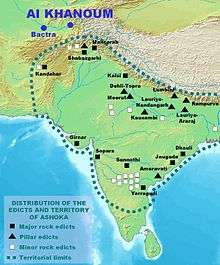 The distribution of the Edicts of Ashoka.[131]
The distribution of the Edicts of Ashoka.[131]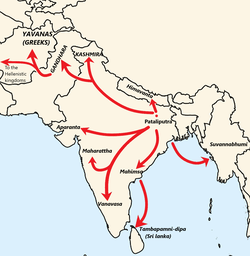 Map of the Buddhist missions during the reign of Ashoka.
Map of the Buddhist missions during the reign of Ashoka.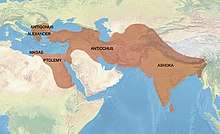 Territories "conquered by the Dharma" according to Major Rock Edict No. 13 of Ashoka (260–218 BCE).[132][133]
Territories "conquered by the Dharma" according to Major Rock Edict No. 13 of Ashoka (260–218 BCE).[132][133]
Also, in the Edicts of Ashoka, Ashoka mentions the Hellenistic kings of the period as recipients of his Buddhist proselytism, although no Western historical record of this event remains:
The conquest by Dharma has been won here, on the borders, and even six hundred yojanas (5,400–9,600 km) away, where the Greek king Antiochos rules, beyond there where the four kings named Ptolemy, Antigonos, Magas and Alexander rule, likewise in the south among the Cholas, the Pandyas, and as far as Tamraparni (Sri Lanka).
— Edicts of Ashoka, 13th Rock Edict, S. Dhammika.
Ashoka also encouraged the development of herbal medicine, for men and animals, in their territories:
Everywhere within Beloved-of-the-Gods, King Piyadasi's [Ashoka's] domain, and among the people beyond the borders, the Cholas, the Pandyas, the Satiyaputras, the Keralaputras, as far as Tamraparni and where the Greek king Antiochos rules, and among the kings who are neighbors of Antiochos, everywhere has Beloved-of-the-Gods, King Piyadasi, made provision for two types of medical treatment: medical treatment for humans and medical treatment for animals. Wherever medical herbs suitable for humans or animals are not available, I have had them imported and grown. Wherever medical roots or fruits are not available I have had them imported and grown. Along roads I have had wells dug and trees planted for the benefit of humans and animals.
The Greeks in India even seem to have played an active role in the spread of Buddhism, as some of the emissaries of Ashoka, such as Dharmaraksita, are described in Pali sources as leading Greek ("Yona") Buddhist monks, active in Buddhist proselytism (the Mahavamsa, XII[134]).
Subhagasena and Antiochos III (206 BCE)
Sophagasenus was an Indian Mauryan ruler of the 3rd century BCE, described in ancient Greek sources, and named Subhagasena or Subhashasena in Prakrit. His name is mentioned in the list of Mauryan princes, and also in the list of the Yadava dynasty, as a descendant of Pradyumna. He may have been a grandson of Ashoka, or Kunala, the son of Ashoka. He ruled an area south of the Hindu Kush, possibly in Gandhara. Antiochos III, the Seleucid king, after having made peace with Euthydemus in Bactria, went to India in 206 BCE and is said to have renewed his friendship with the Indian king there:
He (Antiochus) crossed the Caucasus and descended into India; renewed his friendship with Sophagasenus the king of the Indians; received more elephants, until he had a hundred and fifty altogether; and having once more provisioned his troops, set out again personally with his army: leaving Androsthenes of Cyzicus the duty of taking home the treasure which this king had agreed to hand over to him.
Timeline
- 322 BCE: Chandragupta Maurya founded the Mauryan Empire by defeating the Nanda Dynasty.
- 317–316 BCE: Chandragupta Maurya conquers the Northwest of the Indian subcontinent.
- 305–303 BCE: Chandragupta Maurya gains territory from the Seleucid Empire.
- 298–269 BCE: Reign of Bindusara, Chandragupta's son. He conquers parts of Deccan, southern India.
- 269–232 BCE: The Mauryan Empire reaches its height under Ashoka, Chandragupta's grandson.
- 261 BCE: Ashoka conquers the kingdom of Kalinga.
- 250 BCE: Ashoka builds Buddhist stupas and erects pillars bearing inscriptions.
- 184 BCE: The empire collapses when Brihadratha, the last emperor, is killed by Pushyamitra Shunga, a Mauryan general and the founder of the Shunga Empire.
In literature
According to Vicarasreni of Merutunga, Mauryans rose to power in 312 BC.[135]
See also
Part of a series on the |
|---|
| History of India |
Satavahana gateway at Sanchi, 1st century CE |
|
Ancient
|
|
Classical
|
|
|
|
Early modern
|
|
Modern
|
|
Related articles
|
| Outline of South Asian history | ||||||||||||||||||||||||||||||||||||||||||||
|---|---|---|---|---|---|---|---|---|---|---|---|---|---|---|---|---|---|---|---|---|---|---|---|---|---|---|---|---|---|---|---|---|---|---|---|---|---|---|---|---|---|---|---|---|
_without_national_boundaries.svg.png) | ||||||||||||||||||||||||||||||||||||||||||||
|
Palaeolithic (2,500,000–250,000 BC) |
||||||||||||||||||||||||||||||||||||||||||||
|
Neolithic (10,800–3300 BC)
|
||||||||||||||||||||||||||||||||||||||||||||
|
Chalcolithic (3500–1500 BC)
|
||||||||||||||||||||||||||||||||||||||||||||
|
Bronze Age (3300–1300 BC)
|
||||||||||||||||||||||||||||||||||||||||||||
|
Iron Age (1500–200 BC)
|
||||||||||||||||||||||||||||||||||||||||||||
|
Middle Kingdoms (230 BC – AD 1206) |
||||||||||||||||||||||||||||||||||||||||||||
|
Late medieval period (1206–1526)
|
||||||||||||||||||||||||||||||||||||||||||||
|
Early modern period (1526–1858)
|
||||||||||||||||||||||||||||||||||||||||||||
|
Colonial states (1510–1961)
|
||||||||||||||||||||||||||||||||||||||||||||
|
Periods of Sri Lanka
|
||||||||||||||||||||||||||||||||||||||||||||
|
Specialised histories |
||||||||||||||||||||||||||||||||||||||||||||
- Pradyota dynasty
- Gupta Empire
- History of India
- List of largest empires that existed in India
- List of Hindu Empires and Dynasties
Notes
- Smith, Vincent Arthur (1920), The Oxford History of India: From the Earliest Times to the End of 1911, Clarendon Press, pp. 104–106
- Majumdar, R. C.; Raychaudhuri, H. C.; Datta, Kalikinkar (1950), An Advanced History of India (Second ed.), Macmillan & Company, p. 104
- Schwartzberg, Joseph E. A Historical Atlas of South Asia, 2nd ed. (University of Minnesota, 1992), Plate III.B.4b (p.18) and Plate XIV.1a-c (p.145)
- Hermann Kulke 2004, p. 69-70.
- Stein, Burton (2010), A History of India, John Wiley & Sons, p. 74, ISBN 978-1-4443-2351-1,
In the past it was not uncommon for historians to conflate the vast space thus outlined with the oppressive realm described in the Arthashastra and to posit one of the earliest and certainly one of the largest totalitarian regimes in all of history. Such a picture is no longer considered believable; at present what is taken to be the realm of Ashoka is a discontinuous set of several core regions separated by very large areas occupied by relatively autonomous peoples.
- Ludden, David (2013), India and South Asia: A Short History, Oneworld Publications, pp. 29–3, ISBN 978-1-78074-108-6,
The geography of the Mauryan Empire resembled a spider with a small dense body and long spindly legs. The highest echelons of imperial society lived in the inner circle composed of the ruler, his immediate family, other relatives, and close allies, who formed a dynastic core. Outside the core, empire travelled stringy routes dotted with armed cities. ... In most janapadas, the Mauryan Empire consisted of strategic urban sites connected loosely to vast hinterlands through lineages and local elites who were there when the Mauryas arrived and were still in control when they left.
- Coningham, Robin; Young, Ruth (2015), The Archaeology of South Asia: From the Indus to Asoka, c.6500 BCE – 200 CE, Cambridge University Press, pp. 451–466, ISBN 978-1-316-41898-7
- Coningham, Robin; Young, Ruth (2015), The Archaeology of South Asia: From the Indus to Asoka, c.6500 BCE – 200 CE, Cambridge University Press, p. 453, ISBN 978-1-316-41898-7
- Dyson, Tim (2018), A Population History of India: From the First Modern People to the Present Day, Oxford University Press, pp. 16–17, ISBN 978-0-19-882905-8,
Magadha power came to extend over the main cities and communication routes of the Ganges basin. Then, under Chandragupta Maurya (c.321–297 bce), and subsequently Ashoka his grandson, Pataliputra became the centre of the loose-knit Mauryan 'Empire' which during Ashoka's reign (c.268–232 bce) briefly had a presence throughout the main urban centres and arteries of the subcontinent, except for the extreme south.
- Avari, Burjor (2007). India, the Ancient Past: A History of the Indian Sub-continent from C. 7000 BC to AD 1200 Taylor & Francis. ISBN 0415356156. pp. 188-189.
- Taagepera, Rein (1979). "Size and Duration of Empires: Growth-Decline Curves, 600 B.C. to 600 A.D.". Social Science History. 3 (3/4): 132. doi:10.2307/1170959. JSTOR 1170959.
- Turchin, Peter; Adams, Jonathan M.; Hall, Thomas D (December 2006). "East-West Orientation of Historical Empires". Journal of World-Systems Research. 12 (2): 223. ISSN 1076-156X. Archived from the original on 17 September 2016. Retrieved 16 September 2016.
- Thanjan, Davis K. (2011). Pebbles. Bookstand Publishing. ISBN 9781589098176.
- Hermann Kulke 2004, pp. xii, 448.
- Thapar, Romila (1990). A History of India, Volume 1. Penguin Books. p. 384. ISBN 0-14-013835-8.
- Turchin, Peter; Adams, Jonathan M.; Hall, Thomas D (December 2006). "East-West Orientation of Historical Empires". Journal of World-Systems Research. 12 (2): 223. ISSN 1076-156X. Archived from the original on 17 September 2016. Retrieved 16 September 2016
- Keay, John (2000). India: A History. Grove Press. p. 82. ISBN 978-0-8021-3797-5.
- R. K. Mookerji 1966, p. 31.
- Seleucus I ceded the territories of Arachosia (modern Kandahar), Gedrosia (modern Balochistan), and Paropamisadae (or Gandhara). Aria (modern Herat) "has been wrongly included in the list of ceded satrapies by some scholars ... on the basis of wrong assessments of the passage of Strabo ... and a statement by Pliny" (Raychaudhuri & Mukherjee 1996, p. 594).
- John D Grainger 2014, p. 109: Seleucus "must ... have held Aria", and furthermore, his "son Antiochos was active there fifteen years later".
- The account of Strabo indicates that the western-most territory of the empire extended from the southeastern Hindu Kush, through the region of Kandahar, to coastal Balochistan to the south of that (Raychaudhuri & Mukherjee 1996, p. 594).
- Sri Lanka and the southernmost parts of India (modern Tamil Nadu and Kerala) remained independent, despite the diplomacy and cultural influence of their larger neighbor to the north (Schwartzberg 1992, p. 18; Kulke & Rothermund 2004, p. 68).
- The empire was once thought to have directly controlled most of the Indian subcontinent excepting the far south, but its core regions are now thought to have been separated by large tribal regions (especially in the Deccan peninsula) that were relatively autonomous. (Kulke & Rothermund 2004, p. 68–71, as well as Stein 1998, p. 74). "The major part of the Deccan was ruled by [Mauryan administration]. But in the belt of land on either side of the Nerbudda, the Godavari and the upper Mahanadi there were, in all probability, certain areas that were technically outside the limits of the empire proper. Ashoka evidently draws a distinction between the forests and the inhabiting tribes which are in the dominions (vijita) and peoples on the border (anta avijita) for whose benefit some of the special edicts were issued. Certain vassal tribes are specifically mentioned." (Raychaudhuri & Mukherjee pp. 275–6)
- Kalinga had been conquered by the preceding Nanda Dynasty but subsequently broke free until it was re-conquered by Ashoka, c. 260 BCE. (Raychaudhuri & Mukherjee, pp. 204–209, pp. 270–271)
- Bhandari, Shirin (5 January 2016). "Dinner on the Grand Trunk Road". Roads & Kingdoms. Retrieved 19 July 2016.
- Hermann Kulke 2004, p. 67.
- Boesche, Roger (1 March 2003). The First Great Political Realist: Kautilya and His Arthashastra. p. 11. ISBN 9780739106075.
- Demeny, Paul George; McNicoll, Geoffrey (May 2003). Encyclopedia of population. ISBN 9780028656793.
- "It is doubtful if, in its present shape, [the Arthashastra] is as old as the time of the first Maurya", as it probably contains layers of text ranging from Maurya times till as late as the 2nd century CE. Nonetheless, "though a comparatively late work, it may be used ... to confirm and supplement the information gleaned from earlier sources". (Raychaudhuri & Mukherjee 1996, pp. 246–247)
- Irfan Habib & Vivekanand Jha 2004, p. 14.
- Singh, Upinder (2008). A History of Ancient and Early Medieval India: From the Stone Age to the 12th Century. Pearson Education India. ISBN 9788131716779.
- Annual Report Of Mysore 1886 To 1903.
- Epigraphia Indica Vol.20. Achaeological Survey of India. 1920. p. 80.
- D. C. Sircar (1968). "The Satavahanas and the Chedis". In R. C. Majumdar (ed.). The Age of Imperial Unity. Bharatiya Vidya Bhavan. p. 215.
- R. K. Mookerji 1966, p. 14.
- R. K. Mookerji 1966, p. 15.
- H. C. Raychaudhuri 1988, p. 140.
- R. K. Mookerji 1966, p. 8.
- Śankar, K. G. (1924). "The Moriyas of the Sangam Works". Journal of the Royal Asiatic Society of Great Britain and Ireland (4): 664–667. ISSN 0035-869X.
- Sugandhi, Namita Sanjay (2008). Between the Patterns of History: Rethinking Mauryan Imperial Interaction in the Southern Deccan. pp. 88–89. ISBN 9780549744412.
- Paul J. Kosmin 2014, p. 31.
-
- "Androcottus, when he was a stripling, saw Alexander himself, and we are told that he often said in later times that Alexander narrowly missed making himself master of the country, since its king was hated and despised on account of his baseness and low birth." Plutarch 62-3 Plutarch 62-3
-
- "He was of humble Indian to a change of rule." Justin XV.4.15 "Fuit hic humili quidem genere natus, sed ad regni potestatem maiestate numinis inpulsus. Quippe cum procacitate sua Nandrum regem offendisset, interfici a rege iussus salutem pedum ceieritate quaesierat. (Ex qua fatigatione cum somno captus iaceret, leo ingentis formae ad dormientem accessit sudoremque profluentem lingua ei detersit expergefactumque blande reliquit. Hoc prodigio primum ad spem regni inpulsus) contractis latronibus Indos ad nouitatem regni sollicitauit." Justin XV.4.15 Archived 1 February 2016 at the Wayback Machine
- Hermann Kulke 2004, p. 69–70.
- Mookerji, Radhakumud (1966). Chandragupta Maurya and His Times. Motilal Banarsidass. p. 27. ISBN 9788120804050.; Mookerji, Radha Kumud (1957). "The Foundation of the Mauryan Empire". In K. A. Nilakanta Sastri (ed.). A Comprehensive History of India, Volume 2: Mauryas and Satavahanas. Orient Longmans. p. 4.: "The Mudrarakshasa further informs us that his Himalayan alliance gave Chandragupta a composite army ... Among these are mentioned the following : Sakas, Yavanas (probably Greeks), Kiratas, Kambojas, Parasikas and Bahlikas."
- Shashi, Shyam Singh (1999). Encyclopaedia Indica: Mauryas. Anmol Publications. p. 134. ISBN 9788170418597.: "Among those who helped Chandragupta in his struggle against the Nandas, were the Sakas (Scythians), Yavanas (Greeks), and Parasikas (Persians)"
- Chandragupta Maurya and His Times, Radhakumud Mookerji, Motilal Banarsidass Publ., 1966, p.26-27 Mookerji, Radhakumud (1966). Chandragupta Maurya and His Times. ISBN 9788120804050. Archived from the original on 27 November 2016. Retrieved 26 November 2016.
- Sir John Marshall, "Taxila", p. 18 et passim
- K. A. Nilakanta Sastri (ed., 1967), Age of the Nandas and Mauryas, p.147
- Chandragupta Maurya and His Times, Radhakumud Mookerji, Motilal Banarsidass Publ., 1966, p.27 Mookerji, Radhakumud (1966). Chandragupta Maurya and His Times. ISBN 9788120804050. Archived from the original on 27 November 2016. Retrieved 26 November 2016.
- Sanskrit original: "asti tava Shaka-Yavana-Kirata-Kamboja-Parasika-Bahlika parbhutibhih Chankyamatipragrahittaishcha Chandergupta Parvateshvara balairudidhibhiriva parchalitsalilaih samantaad uprudham Kusumpurama". From the French translation, in "Le Ministre et la marque de l'anneau", ISBN 2-7475-5135-0
- From Polis to Empire, the Ancient World, C. 800 B.C.-A.D. 500. Greenwood Publishing. 2002. ISBN 0313309426. Retrieved 16 August 2019.
- Kistler, John M. (2007). War Elephants. University of Nebraska Press. p. 67. ISBN 978-0803260047. Retrieved 16 August 2019.
- s, deepak (25 October 2016). Indian civilization. deepak shinde.
- Paul J. Kosmin 2014, p. 38.
- Arrian. "Book 5". Anabasis.
Megasthenes lived with Sibyrtius, satrap of Arachosia, and often speaks of his visiting Sandracottus, the king of the Indians.
- "In the royal residences in India where the greatest of the kings of that country live, there are so many objects for admiration that neither Memnon's city of Susa with all its extravagance, nor the magnificence of Ectabana is to be compared with them. ... In the parks, tame peacocks and pheasants are kept." Aelian, Characteristics of animals book XIII, Chapter 18, also quoted in The Cambridge History of India, Volume 1, p411
- Romila Thapar (1961), Aśoka and the decline of the Mauryas, Volume 5, p.129, Oxford University Press. "The architectural closeness of certain buildings in Achaemenid Iran and Mauryan India have raised much comment. The royal palace at Pataliputra is the most striking example and has been compared with the palaces at Susa, Ecbatana, and Persepolis."
- Upinder Singh 2008, p. 331.
- Paul J. Kosmin 2014, p. 32.
- Chatterjee, Suhas (1998). Indian Civilization and Culture. M.D. Publications. ISBN 9788175330832.
- Dikshitar, V. R. Ramachandra (1993). The Mauryan Polity. Motilal Banarsidass. ISBN 9788120810235.
- R. K. Mookerji 1966, pp. 39–40.
- Geoffrey Samuel 2010, pp. 60.
- Romila Thapar 2004, p. 178.
- R. K. Mookerji 1966, pp. 39–41.
- Srinivasachariar 1974, p. lxxxvii.
- Vincent Arthur Smith (1920). Asoka, the Buddhist emperor of India. Oxford: Clarendon Press. pp. 18–19. ISBN 9788120613034.
- Rajendralal Mitra (1878). "On the Early Life of Asoka". Proceedings of the Asiatic Society of Bengal. Asiatic Society of Bengal: 10.
- Motilal Banarsidass (1993). "The Minister Cāṇakya, from the Pariśiṣtaparvan of Hemacandra". In Phyllis Granoff (ed.). The Clever Adulteress and Other Stories: A Treasury of Jaina Literature. Translated by Rosalind Lefeber. pp. 204–206.
- Paul J. Kosmin 2014, p. 35.
- Alain Daniélou 2003, p. 108.
- Dineschandra Sircar 1971, p. 167.
- William Woodthorpe Tarn (2010). The Greeks in Bactria and India. Cambridge University Press. p. 152. ISBN 9781108009416.
- Mookerji Radhakumud (1962). Asoka. Motilal Banarsidass. p. 8. ISBN 978-81-208-0582-8. Archived from the original on 10 May 2018.
- Alain Daniélou 2003, p. 109.
- Eugène Burnouf (1911). Legends of Indian Buddhism. New York: E. P. Dutton. p. 59.
- S. N. Sen 1999, p. 142.
- "Three Greek ambassadors are known by name: Megasthenes, ambassador to Chandragupta; Deimachus, ambassador to Chandragupta's son Bindusara; and Dyonisius, whom Ptolemy Philadelphus sent to the court of Ashoka, Bindusara's son", McEvilley, p.367
- India, the Ancient Past, Burjor Avari, pp. 108–109
- Arthur Llewellyn Basham, History and doctrines of the Ājīvikas: a vanished Indian religion, pp. 138, 146
- Anukul Chandra Banerjee, Buddhism in comparative light, p. 24
- Beni Madhab Barua, Ishwar Nath Topa, Ashoka and his inscriptions, Volume 1, p. 171
- Kashi Nath Upadhyaya (1997). Early Buddhism and the Bhagavadgita. Motilal Banarsidass. p. 33. ISBN 9788120808805.
- Fitzedward Hall, ed. (1868). The Vishnu Purana. IV. Translated by H. H. Wilson. Trübner & Co. p. 188.
- Allchin, F. R.; Erdosy, George (1995). The Archaeology of Early Historic South Asia: The Emergence of Cities and States. Cambridge: Cambridge University Press. p. 306.
- Edicts of Ashoka, 13th Rock Edict, translation S. Dhammika.
- https://www.oxfordscholarship.com/view/10.1093/acprof:oso/9780198077244.001.0001/acprof-9780198077244-chapter-7
- Singh 2012, p. 131, 143.
- According to the Ashokavadana
- Sir John Marshall (1990), "A Guide to Sanchi", Eastern Book House, ISBN 81-85204-32-2, p. 38
- E. Lamotte, History of Indian Buddhism, Institut Orientaliste, Louvain-la-Neuve 1988 (1958)
- Romila Thapar (1960), Aśoka and the Decline of the Mauryas, Oxford University Press, p. 200
- Kangle, R. P. (1986). A Study. Motilal Banarsidass Publ. ISBN 978-81-208-0041-0.
- Gabriel A, Richard (30 November 2006). The Ancient World :Volume 1 of Soldiers' lives through history. Greenwood Publishing Group. p. 28. ISBN 9780313333484.
- R. C. Majumdar 2003, p. 107.
- Kulke, Herman (2004). History of India. Routledge. p. 79.
- Indian History. Allied Publishers. 1988. ISBN 9788184245684.
- Narain Singh Kalota (1978). India As Described By Megasthenes.
- The Economic History of the Corporate Form in Ancient India. Archived 4 February 2016 at the Wayback Machine University of Michigan.
- CNG Coins Archived 27 August 2017 at the Wayback Machine
- R. K. Mookerji 1966, pp. 39-41.
- Hermann Kulke 2004, pp. 64-65.
- John Cort 2010, p. 142.
- John Cort 2010, p. 199.
- Tukol, T. K. Jainism in South India. Archived from the original on 4 March 2016.
- Jerry Bentley, Old World Encounters: Cross-Cultural Contacts in Pre-Modern Times (New York: Oxford University Press), 46
- "L'age d'or de l'Inde Classique", p23
- "L'age d'or de l'Inde Classique", p22
- Described in Marshall p.25-28 Ashoka pillar.
- Ramaprasad, Chanda (1919). Indian Antiquary A Journal Of Oriental Research Vol.48. pp. 25-28.
- Allen, Charles (2012). Ashoka: The Search for India's Lost Emperor. London: Hachette Digital. p. 274. ISBN 978-1-408-70388-5.
- Rangarajan, M. (2001) India's Wildlife History, pp 7.
- Rangarajan, M. (2001) India's Wildlife History, pp 8.
- Mookerji, Radhakumud (1966). Chandragupta Maurya and His Times. Motilal Banarsidass. pp. 16–17. ISBN 9788120804050.
- "Plutarch, Alexander, chapter 1, section 1".
- "(Transitum deinde in Indiam fecit), quae post mortem Alexandri, ueluti ceruicibus iugo seruitutis excusso, praefectos eius occiderat. Auctor libertatis Sandrocottus fuerat, sed titulum libertatis post uictoriam in seruitutem uerterat; 14 siquidem occupato regno populum quem ab externa dominatione uindicauerat ipse seruitio premebat." Justin XV.4.12–13 Archived 20 April 2017 at the Wayback Machine
- "Molienti deinde bellum aduersus praefectos Alexandri elephantus ferus infinitae magnitudinis ultro se obtulit et ueluti domita mansuetudine eum tergo excepit duxque belli et proeliator insignis fuit. Sic adquisito regno Sandrocottus ea tempestate, qua Seleucus futurae magnitudinis fundamenta iaciebat, Indiam possidebat." Justin XV.4.19 Archived 20 April 2017 at the Wayback Machine
- "Appian, The Syrian Wars 11". Archived from the original on 3 November 2007.
- R. C. Majumdar 2003, p. 105.
- Ancient India, (Kachroo, p.196)
- The Imperial Gazetteer of India (Hunter, p.167)
- The evolution of man and society (Darlington, p.223)
- W. W. Tarn (1940). "Two Notes on Seleucid History: 1. Seleucus' 500 Elephants, 2. Tarmita", The Journal of Hellenic Studies 60, p. 84–94.
- Paul J. Kosmin 2014, p. 37.
- "Pliny the Elder, The Natural History (eds. John Bostock, H. T. Riley)". Archived from the original on 28 July 2013.
- Vincent A. Smith (1998). Ashoka. Asian Educational Services. ISBN 81-206-1303-1.
- Walter Eugene Clark (1919). "The Importance of Hellenism from the Point of View of Indic-Philology", Classical Philology 14 (4), pp. 297–313.
- "Problem while searching in The Literature Collection". Archived from the original on 13 March 2007.
- "The Literature Collection: The deipnosophists, or, Banquet of the learned of Athenæus (volume III): Book XIV". Archived from the original on 11 October 2007.
- Reference: "India: The Ancient Past" p.113, Burjor Avari, Routledge, ISBN 0-415-35615-6
- Kosmin, Paul J. (2014). The Land of the Elephant Kings. Harvard University Press. p. 57. ISBN 9780674728820.
- Thomas Mc Evilly "The shape of ancient thought", Allworth Press, New York, 2002, p.368
- Mahavamsa chapter XII Archived 5 September 2006 at the Wayback Machine
- Kailash Chand Jain 1991, p. 85.
Sources
- Alain Daniélou (2003). A Brief History of India. Simon and Schuster. ISBN 978-1-59477-794-3.CS1 maint: ref=harv (link)
- Arthur Llewellyn Basham (1951). History and doctrines of the Ājīvikas: a vanished Indian religion. foreword by L. D. Barnett (1 ed.). London: Luzac.
- Burton Stein (1998). A History of India (1st ed.), Oxford: Wiley-Blackwell.
- Geoffrey Samuel (2010). The Origins of Yoga and Tantra. Indic Religions to the Thirteenth Century. Cambridge University Press.
- H. C. Raychaudhuri (1988) [1967]. "India in the Age of the Nandas". In K. A. Nilakanta Sastri (ed.). Age of the Nandas and Mauryas (Second ed.). Delhi: Motilal Banarsidass. ISBN 978-81-208-0466-1.CS1 maint: ref=harv (link)
- H. C. Raychaudhuri; B. N. Mukherjee (1996). Political History of Ancient India: From the Accession of Parikshit to the Extinction of the Gupta Dynasty. Oxford University Press.
- Hermann Kulke; Dietmar Rothermund (2004). A History of India (4th ed.). London: Routledge. ISBN 0-415-15481-2.
- Irfan Habib; Vivekanand Jha (2004). Mauryan India. A People's History of India. Aligarh Historians Society / Tulika Books. ISBN 978-81-85229-92-8.CS1 maint: ref=harv (link)
- J. E. Schwartzberg (1992). A Historical Atlas of South Asia. University of Oxford Press.
- John Keay (2000). India, a History. New York: Harper Collins Publishers.
- John Cort (2010). Framing the Jina: Narratives of Icons and Idols in Jain History. Oxford University Press. ISBN 978-0-19-538502-1.CS1 maint: ref=harv (link)
- John D Grainger (2014). Seleukos Nikator (Routledge Revivals): Constructing a Hellenistic Kingdom. Taylor & Francis. ISBN 978-1-317-80098-9.CS1 maint: ref=harv (link)
- Kailash Chand Jain (1991). Lord Mahāvīra and His Times. Motilal Banarsidass. ISBN 978-81-208-0805-8.CS1 maint: ref=harv (link)
- Paul J. Kosmin (2014). The Land of the Elephant Kings: Space, Territory, and Ideology in Seleucid Empire. Harvard University Press. ISBN 978-0-674-72882-0.
- R. K. Mookerji (1966). Chandragupta Maurya and His Times. Motilal Banarsidass. ISBN 978-81-208-0405-0.CS1 maint: ref=harv (link)
- R. C. Majumdar (2003) [1952]. Ancient India. Motilal Banarsidass. ISBN 81-208-0436-8.CS1 maint: ref=harv (link)
- Romila Thapar (2004) [first published by Penguin in 2002]. Early India: From the Origins to A.D. 1300. University of California Press. ISBN 978-0-520-24225-8.
- S. N. Sen (1999). Ancient Indian History and Civilization. New Age International. ISBN 978-81-224-1198-0.CS1 maint: ref=harv (link)
- Upinder Singh (2008). A History of Ancient and Early Medieval India: From the Stone Age to the 12th Century. Pearson. ISBN 978-81-317-1677-9.CS1 maint: ref=harv (link)
- Thapar, Romila (2013), The Past Before Us, Harvard University Press, ISBN 978-0-674-72651-2
External links
| Wikimedia Commons has media related to Mauryan Empire. |
| Preceded by Nanda dynasty |
Magadha dynasties Maurya Empire |
Succeeded by Shunga dynasty |
| Timeline and cultural period |
Northwestern India (Punjab-Sapta Sindhu) |
Indo-Gangetic Plain | Central India | Southern India | ||
| Upper Gangetic Plain (Ganga-Yamuna doab) |
Middle Gangetic Plain | Lower Gangetic Plain | ||||
| IRON AGE | ||||||
| Culture | Late Vedic Period | Late Vedic Period (Srauta culture)[lower-alpha 1] Painted Grey Ware culture |
Late Vedic Period (Shramanic culture)[lower-alpha 2] Northern Black Polished Ware |
Pre-history | ||
| 6th century BC | Gandhara | Kuru-Panchala | Magadha | Adivasi (tribes) | ||
| Culture | Persian-Greek influences | "Second Urbanisation" Rise of Shramana movements Jainism - Buddhism - Ājīvika - Yoga |
Pre-history | |||
| 5th century BC | (Persian conquests) | Shaishunaga dynasty | Adivasi (tribes) | |||
| 4th century BC | (Greek conquests) | Nanda empire | ||||
| HISTORICAL AGE | ||||||
| Culture | Spread of Buddhism | Pre-history | Sangam period (300 BC – 200 AD) | |||
| 3rd century BC | Maurya Empire | Early Cholas Early Pandyan Kingdom Satavahana dynasty Cheras 46 other small kingdoms in Ancient Thamizhagam | ||||
| Culture | Preclassical Hinduism[lower-alpha 3] - "Hindu Synthesis"[lower-alpha 4] (ca. 200 BC - 300 AD)[lower-alpha 5][lower-alpha 6] Epics - Puranas - Ramayana - Mahabharata - Bhagavad Gita - Brahma Sutras - Smarta Tradition Mahayana Buddhism |
Sangam period (continued) (300 BC – 200 AD) | ||||
| 2nd century BC | Indo-Greek Kingdom | Shunga Empire Maha-Meghavahana Dynasty |
Early Cholas Early Pandyan Kingdom Satavahana dynasty Cheras 46 other small kingdoms in Ancient Thamizhagam | |||
| 1st century BC | ||||||
| 1st century AD | Kuninda Kingdom | |||||
| 2nd century | Kushan Empire | |||||
| 3rd century | Kushano-Sasanian Kingdom | Kushan Empire | Western Satraps | Kamarupa kingdom | Kalabhra dynasty Pandyan Kingdom (Under Kalabhras) | |
| Culture | "Golden Age of Hinduism"(ca. AD 320-650)[lower-alpha 7] Puranas Co-existence of Hinduism and Buddhism | |||||
| 4th century | Kidarites | Gupta Empire Varman dynasty |
Kalabhra dynasty Pandyan Kingdom (Under Kalabhras) Kadamba Dynasty Western Ganga Dynasty | |||
| 5th century | Hephthalite Empire | Alchon Huns | Kalabhra dynasty Pandyan Kingdom (Under Kalabhras) Vishnukundina | |||
| 6th century | Nezak Huns Kabul Shahi |
Maitraka | Adivasi (tribes) | Badami Chalukyas Kalabhra dynasty Pandyan Kingdom (Under Kalabhras) | ||
| Culture | Late-Classical Hinduism (ca. AD 650-1100)[lower-alpha 8] Advaita Vedanta - Tantra Decline of Buddhism in India | |||||
| 7th century | Indo-Sassanids | Vakataka dynasty Empire of Harsha |
Mlechchha dynasty | Adivasi (tribes) | Pandyan Kingdom (Under Kalabhras) Pandyan Kingdom(Revival) Pallava | |
| 8th century | Kabul Shahi | Pala Empire | Pandyan Kingdom Kalachuri | |||
| 9th century | Gurjara-Pratihara | Rashtrakuta dynasty Pandyan Kingdom Medieval Cholas Pandyan Kingdom (Under Cholas) Chera Perumals of Makkotai | ||||
| 10th century | Ghaznavids | Pala dynasty Kamboja-Pala dynasty |
Kalyani Chalukyas Medieval Cholas Pandyan Kingdom (Under Cholas) Chera Perumals of Makkotai Rashtrakuta | |||
References and sources for table References
Sources
| ||||||

